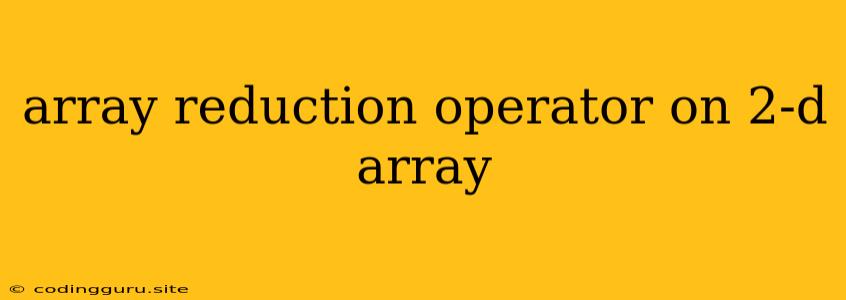Understanding the Power of Array Reduction Operators on 2-D Arrays
Arrays, especially multi-dimensional ones like 2-D arrays, are fundamental data structures in programming. They allow us to organize and manipulate data efficiently. One of the most powerful tools for working with arrays is the array reduction operator.
What is an array reduction operator?
In essence, an array reduction operator takes a collection of values (an array) and transforms it into a single value. This is achieved by applying a specific operation iteratively to each element in the array, combining the results along the way.
How do reduction operators apply to 2-D arrays?
While the concept remains the same, applying reduction operators to 2-D arrays introduces additional dimensions to consider. We can choose to reduce the array along rows, columns, or even the entire array. Let's break down some common use cases.
Reducing by Rows
Imagine you have a 2-D array representing a table of sales data, with each row representing a different product and each column representing a different month's sales. You might want to find the total sales for each product, which would involve reducing each row of the array.
Example:
sales = [[100, 200, 150],
[50, 100, 200],
[200, 150, 100]]
total_sales_per_product = []
for row in sales:
total_sales = sum(row)
total_sales_per_product.append(total_sales)
In this example, we iterate through each row of the sales array and use the sum() function to calculate the total sales for that product.
Reducing by Columns
Another common scenario involves reducing by columns. Let's say you want to calculate the average monthly sales across all products. This would require reducing each column of the array.
Example:
sales = [[100, 200, 150],
[50, 100, 200],
[200, 150, 100]]
average_sales_per_month = []
for column_index in range(len(sales[0])):
column_sum = 0
for row in sales:
column_sum += row[column_index]
average_sales_per_month.append(column_sum / len(sales))
Here, we iterate through each column index and sum the sales for that month across all products. Finally, we calculate the average by dividing by the total number of products.
Reducing the Entire Array
In some cases, you might want to reduce the entire 2-D array to a single value. For instance, you could calculate the total sales across all products and all months.
Example:
sales = [[100, 200, 150],
[50, 100, 200],
[200, 150, 100]]
total_sales = 0
for row in sales:
for value in row:
total_sales += value
Here, we iterate through every element in the array and sum them together to get the total sales.
Key Considerations for Efficient Reduction
1. Understanding the Target Operation:
- Be clear about what you want to achieve. Do you need a sum, average, maximum, minimum, or some other calculation?
2. Choosing the Right Approach:
- For simple operations like sum or average: Use built-in functions and loops as shown in the examples above.
- For more complex operations: Explore libraries or frameworks that provide specialized functions for array reduction (e.g., NumPy in Python, or libraries for your specific language).
3. Utilizing Library Functions:
- Libraries like NumPy in Python offer powerful functions for array operations, including reduction. These functions are often highly optimized for performance.
Example Using NumPy
import numpy as np
sales = np.array([[100, 200, 150],
[50, 100, 200],
[200, 150, 100]])
# Total sales for each product (row-wise reduction)
total_sales_per_product = np.sum(sales, axis=1)
# Average sales for each month (column-wise reduction)
average_sales_per_month = np.mean(sales, axis=0)
# Total sales across all products and months (reduction of entire array)
total_sales = np.sum(sales)
Benefits of using NumPy:
- Concise Syntax: NumPy simplifies array operations with its powerful functions.
- Performance Optimization: NumPy utilizes highly optimized algorithms, leading to faster execution times, especially for large arrays.
Conclusion
Mastering the concept of array reduction operators is essential for efficiently processing and analyzing data stored in 2-D arrays. By choosing the right reduction operation and leveraging the power of libraries like NumPy, you can achieve impressive results in your programs. Remember to carefully analyze your data and choose the most efficient approach for your specific needs.
